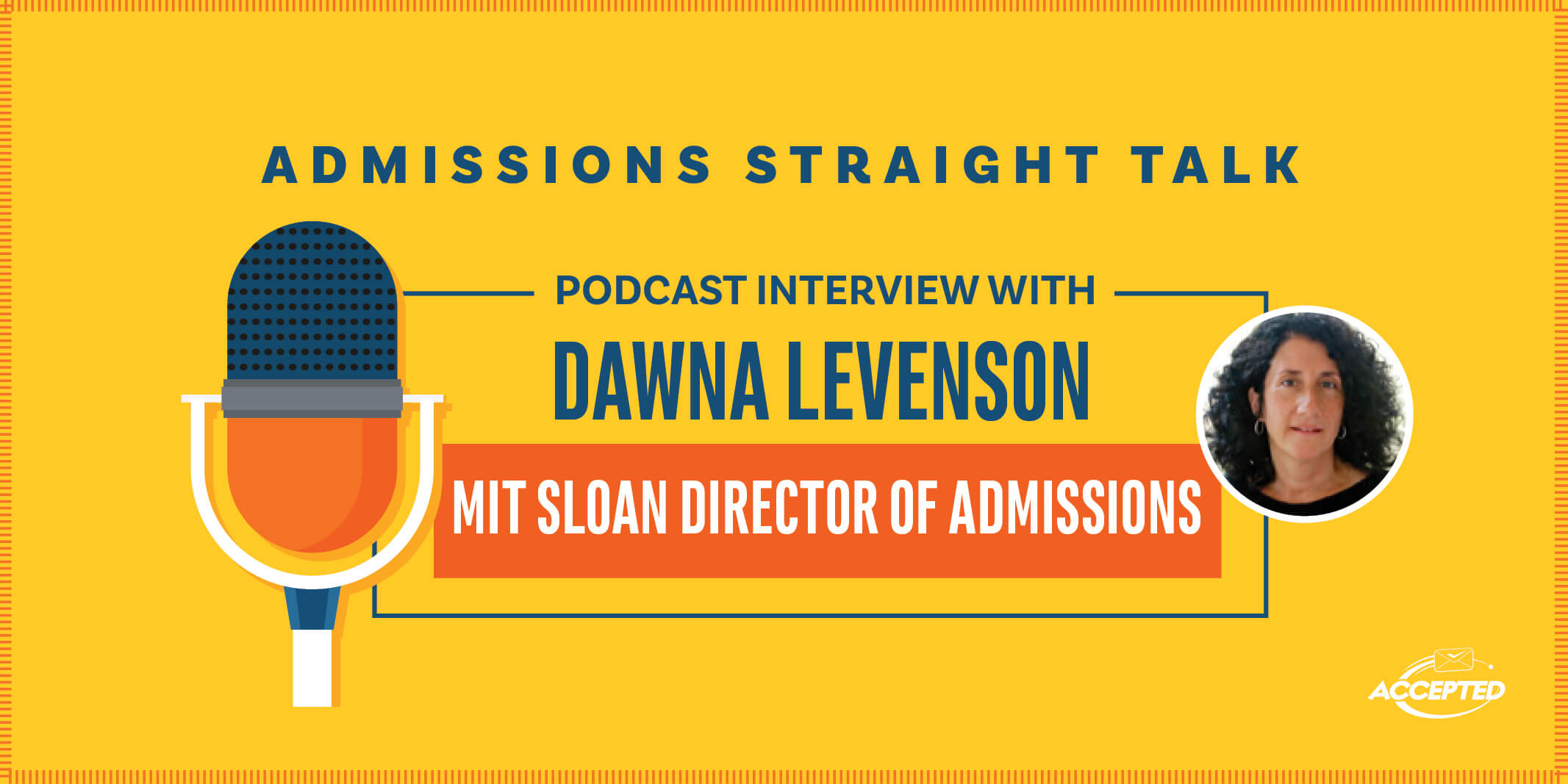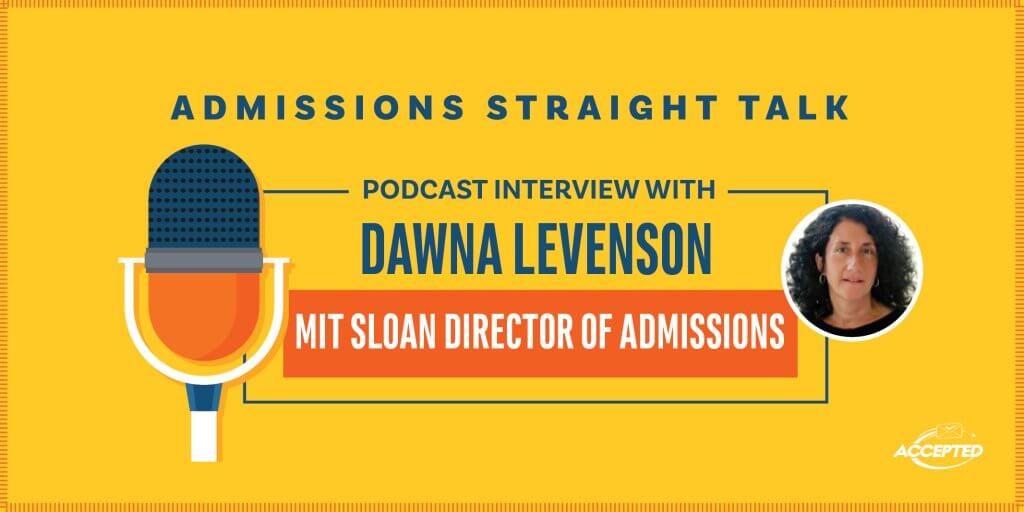
We are pleased to welcome back Dawna Levenson, Director of Admissions at MIT Sloan. Dawna earned her bachelors and masters in Management Science at MIT Sloan, worked in consulting, and then returned to MIT Sloan in 2007 as Associate Director of Academic Programs. She moved into Admissions in 2012 and became Director of Admissions in 2013.
Can you give an overview of MIT Sloan’s MBA program focusing on its distinctive features? [1:20]
My focus today is on our two-year MBA program. We have a one-semester core, and three semesters to shape curriculum to meet individual interests. We continue to have three tracks specific to the MBA program – entrepreneurship, finance and enterprise management. We also have three certificates – sustainability, healthcare, and this year we just introduced business analytics. These are designed in such a way that a student can do a track and a certificate, so for example if you want to do the finance track and apply it to the healthcare industry. One significant difference between tracks and certificates is that tracks are very focused on MBA students, and certificates are available to the entire MIT community.
So if somebody pursues a certificate are they likely to take classes outside of Sloan? [2:48]
Certificates are housed at Sloan, and I believe the majority of classes within the certificate (some are required and some are elective) are in fact Sloan classes. For the tracks they are exclusively Sloan classes.
What’s new at MIT Sloan? [3:42]
In addition to the analytics certificate, there is also an awful lot of activity around fintech – new courses and a club. We also have a new lab course which is USA Lab. We have been doing action learning labs for many years, mostly focused outside of the US, and we’ve added this one to really focus on the United States. It will be offered for the first time in Spring 2018. The focus of our lab courses is on development and opportunities for growth. Within the US there are many opportunities for growth – in Michigan and Mississippi, for example. The labs are entrepreneurially focused, with the idea being that a start-up business is aimed to help a specific geography and business in the area itself.
MIT Sloan is famous for its action-learning and its labs. Can you provide an example or two of Sloan’s hands-on approach? [6:16]
One company that is a great example is Sanergy. The company was born at MIT Sloan from the 100K competition, and is now a viable company. It started out in areas of rural Africa to provide water and sanitation and now is turning waste into fertilizer. Now they have come back to us and sponsor action learning courses so it is really nice to see it come full circle.
Can you describe MIT’s newest certificate program in Business Analytics, and the differences with the Master of Business Analytics? [7:25]
The Master of Business Analytics is a standalone degree program. We just graduated our first class of 16, our second class of 30 is currently on campus, and we are recruiting for our next class which will be 45 students. The degree is really targeted at early stage professionals, and the majority of our students are coming straight from undergrad. It is not that different from the profile of our Master of Finance program, just that students have different interests. The certificate is available to all of our students, most of whom have 4-5 years of professional experience. The degree has helped us create new classes that are in the certificate program as well. The analytics certificate has already become hugely popular across the MBA program, across Sloan, and in the EMBA program as well.
MIT Sloan is well-known for its strength in entrepreneurship. What are one or two of the coolest things a recent Sloan grad is doing? [10:29]
Shireen Yates is currently the CEO and Co-Founder of Nima, which makes a small device for people with celiac disease to use when eating out. You can take a small piece of food and discreetly put it in the device, shake it up and it gives you the gluten content to tell if it is safe to eat. Shireen is not a scientist at all, but she suffers from celiac, and while she was at MIT she met the other co-founder who had the pathology background, so together they have developed it and are going to market. This is a great example of one of the strengths of MIT Sloan – the cross-campus collaboration.
Let’s turn to the application. Sloan has a distinctive approach to the non-academic sections of the application. It requires
• A one-page resume
• A 300-word cover letter providing one or more examples of how you meet Sloan’s criteria
• 60-second video to introduce themselves to classmates
• If invited to interview, an applicant needs to submit an additional essay (250-word max) “In 250 words or less, please describe how you, as a member of the MIT Sloan community, would work to create a campus that is welcoming, inclusive and increasingly diverse.”
Can you tell us a bit more about why you use this structure? [13:01]
We moved the second essay to the interview essay because we came to realize that a single essay was enough to determine whether or not we wanted to invite someone for an interview, and wanted to remove some barriers to entry. The second essay is all about fit, our mission, and commitment to diversity. The essay makes applicants stop and think prior to the interview about culture and whether or not Sloan could be the right community for them, as we continue to assess them. So we love it.
MIT Sloan is using GMAC’s Common Letter of Recommendation. How is that working for you? Why did you switch? [15:21]
We started using it for a few reasons. We have representation on the development team, so the data we are looking for from recommenders is there in this format. We also believe in the long-term vision that GMAC has to create a clearinghouse to make it easier on the applicant and the recommender to spend more time on a single quality recommendation for multiple schools as opposed to having to tailor recommendations for different schools. In the end I think we will get a better quality product from the recommenders and the first step is individual schools adopting it, so from our standpoint there was nothing to lose and a lot to gain.
What can an applicant expect in an interview at Sloan? [16:33]
An interview continues to build on information gathered from the application. We try for them all to be in person. Sometimes we have to use Skype due to a true scheduling conflict, but when possible we like to do them face-to-face. We pretty much travel the globe to do admissions interviews, but people are always welcome and encouraged to come to Cambridge. The interview typically lasts 30-45 minutes. If your interview is 28 minutes don’t read too much into it!! Sometimes we get all the info we need in a shorter period of time. The length of time really is no indicator at all. The first part of the interview is most likely follow up from the application – further explanation on a series of jobs, or an employment gap, essentially probing info from the application. The second part is a series of behavioral questions, i.e. “Tell me about a time when you had to convince an individual or group to do something one way when they wanted to do it another. What was the situation, what was your role, and how did you convince them.” The number of behavioral questions we ask will vary depending on how lengthy the individual’s responses, but probably between 4-6 questions. And then the third section is in fact the opportunity for the interviewee to ask us questions. This is the chance to stand out with the types of questions they are asking and to show they have done their homework. Don’t ask questions that can easily be found on the website. Maybe ask about personal interests and how they will be satisfied by the program. Basically, ask thoughtful questions. If you come here to campus you will also have the opportunity to have lunch with students as well.
Many schools have blind interviews, where the interviewer has only seen the applicant’s resume. The interviewer at Sloan is an admissions officer, correct? [19:52]
Correct. Within the Sloan community we have a core group of people who do the interviews. They will have reviewed your entire application prior to the interview, and will know a lot about the interviewee before we sit down and chat with them.
What should applicants do and not do if waitlisted at MIT Sloan? [21:01]
Individuals who are waitlisted in round 1 will automatically be included as part of our round 2. There is a real possibility we could take someone from round 1 off the waitlist if they are stronger than a round 2 applicant. In terms of what to send us, people are more than welcome to send us relevant updates. When they received their waitlist letter they received our email as well as an invitation to a waitlist chat. We don’t have further face-to-face conversations. People should use their best judgment with regard to how often they send updates. They are also welcome to attend events. With ambassador events, we ask they don’t attend those if they have done so before. We also don’t encourage people to get on a plane and sit in the lobby and hope to meet with us. A little judgment goes a long way.
We used to keep people waitlisted in round 1 to round 3 (if not accepted off the waitlist in round 2), but now for the most part we are only looking at people to admit from round 1 in round 2, or reject. There may always be an exception, but that’s the general rule. We ask people at every point in the process whether or not they want to remain on the waitlist.
How is recruiting from an admissions standpoint changing at MIT Sloan? [24:47]
One thing we are excited to be doing is livestreaming our monthly info sessions. Once a month a panel of current students, about 4-6 and a mix of first and second years, gathers to a full room here and we livestream it around the world. We have had up to 500 people register and over 200 people sign in. We encourage interested applicants to join in every month because with different panels you can get a different experience every time. These sessions are all available on our YouTube channel after the fact.
What advice — final words of wisdom — do you have for MBA applicants planning to submit an application January 17, or in round 3? [26:46]
If you are comfortable that your application accurately reflects who you are, hit submit for round 2. Do not wait for round 3. At any given time we are looking to offer as many seats as possible to as many qualified applicants as we can. In round 1, we admitted X people, in round 2 we have fewer seats to fill, and by round 3 we will have even fewer seats.
If you are looking to put the finishing touches on your essay, we recommend you have two people review – someone who knows you really well and can tell you if it sounds like you, and someone who you trust but maybe doesn’t know you as well to get a sense of what the essay does sound like, and judge whether or not it’s the way you want it to be.
You should also reach out to recommenders to let them know your recommendation letters are almost due.
Finally, we have posted some helpful videos on social media. There are lots of different resources available for guidance.
If someone is trying to decide whether to submit a round 3 application to MIT Sloan or wait until R1 of next year, what advice would you give them? What criteria would you suggest for them? [29:10]
I think that the priority is your personal preference. What is your personal situation that is driving you to apply now? I would not discourage someone from applying in round 3 if that works for you. Worst case you are rejected and you apply again next year. For us, a reapplicant is not a stigma. We admit many reapplicants.
What advice do you have for those planning ahead to apply in the 2018-19 application cycle? [30:58]
Come visit! Come to our events. Come to campus. Reach out to people in your network who are from Sloan or who know people from Sloan. Get to know the people, the students, the campus, follow us on social media. It is not too early to start shopping around. If you think of an MBA as a product there are a lot of great products out there for people, and you should see what’s out there.
Dawna, thank you so much for joining me today. Where can listeners and potential applicants learn more about MIT Sloan’s MBA program? [32:07]
Follow us on Facebook, Twitter, Instagram, and YouTube.
Related Links:
• MIT Sloan School Of Management Admissions Website
• Accepted’s MIT Sloan 2017-18 MBA Essay Tips & Deadlines
• Accepted’s 2017-18 MIT Executive MBA Application Essay Tips
• Accepted MBA Admissions Consulting Services
Related Shows:
• Insights into MIT Sloan MBA Admissions with Dawna Levenson
• MIT Sloan Master in Finance: How to Get In!
• Contemplating a Career in Data Science/Business Analytics?
Subscribe:
The post All the Details About the Full-Time MIT Sloan MBA Program [Episode 241] appeared first on Accepted Admissions Blog.





No comments:
Post a Comment